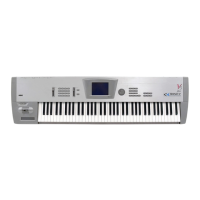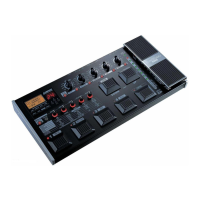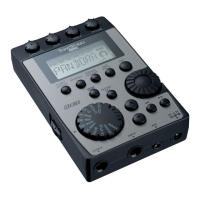Do you have a question about the Korg Triton-Rack and is the answer not in the manual?
Select and play programs, use Performance Editor and arpeggio patterns.
Set basic program parameters like Oscillator and Multisample.
Set pitch parameters, including Pitch EG settings.
Configure Filter 1 settings and its modulation.
Adjust Amp 1 settings and pan.
Configure LFO settings for oscillators.
Set arpeggiator parameters for programs.
Configure insert effect routing and settings.
Select and configure master effects and Master EQ.
Select and play combinations, set timbre parameters.
Select programs and configure mixer settings for timbres.
Set MIDI, OSC, and Pitch settings for timbres.
Configure key zone settings for timbres.
Configure velocity zone settings for timbres.
Set arpeggiator parameters for combinations.
Configure insert effect routing and settings.
Select and configure master effects and Master EQ.
Select multis, set track parameters like program and pan.
Set MIDI, OSC, and Pitch settings for tracks.
Configure key zone settings for tracks.
Configure velocity zone settings for tracks.
Record and edit patterns, configure RPPR settings.
Set arpeggiator parameters for multis.
Configure insert effect routing and settings.
Select and configure master effects and Master EQ.
Record samples, set input level and basic sampling settings.
Perform waveform editing on recorded samples.
Select and play programs, use Performance Editor and arpeggio patterns.
Set basic program parameters like Oscillator and Multisample.
Set pitch parameters, including Pitch EG settings.
Configure Filter 1 settings and its modulation.
Adjust Amp 1 settings and pan.
Configure LFO settings for oscillators.
Set arpeggiator parameters for programs.
Configure insert effect routing and settings.
Select and configure master effects and Master EQ.
Select and play combinations, set timbre parameters.
Select programs and configure mixer settings for timbres.
Set MIDI, OSC, and Pitch settings for timbres.
Configure key zone settings for timbres.
Configure velocity zone settings for timbres.
Set arpeggiator parameters for combinations.
Configure insert effect routing and settings.
Select and configure master effects and Master EQ.
Select multis, set track parameters like program and pan.
Set MIDI, OSC, and Pitch settings for tracks.
Configure key zone settings for tracks.
Configure velocity zone settings for tracks.
Record and edit patterns, configure RPPR settings.
Set arpeggiator parameters for multis.
Configure insert effect routing and settings.
Select and configure master effects and Master EQ.
Record samples, set input level and basic sampling settings.
Perform waveform editing on recorded samples.
| Polyphony | 62 voices |
|---|---|
| Oscillators | 2 per voice |
| Multitimbral | 16 parts |
| Effects | Yes |
| MIDI | In, Out, Thru |
| ROM | 32 MB |
| Number of Effects | 5 Insert, 2 Master |
| Sampling | Optional (with EXB-SMPL board) |
| Outputs | 6 individual outputs, 2 main outputs |
| Memory | 512 Combinations, 64 Drum Programs |
| Storage | SmartMedia card |
| Power Supply | AC power supply |
| Expansion | Yes (EXB series) |
| Waveforms | 425 Multi-samples + 417 Drum samples |











